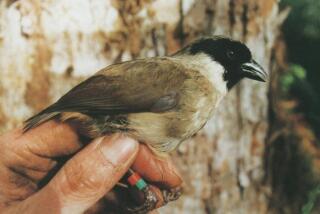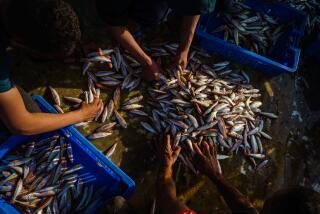Alien Species’ Invasions Leave No Continent Untouched
In New York’s Central Park, the sight of gray squirrels hiding acorns is a sure sign that winter is coming. But in London, seeing a gray squirrel scamper across Hyde Park raises ecological alarms.
Fifty years after the North American gray squirrel was imported to Europe, it has virtually wiped out native red squirrels in England. It is doing the same in northern Italy, while damaging valuable nut crops and hardwood forests.
European ecologists are trying to repel the American intruder with poisoned bait and traps, with only partial success.
“Wherever the gray squirrel arrives, the red squirrel soon becomes locally extinct,” declares Piero Genovesi of Italy’s National Institute for Wildlife in Bologna. “The gray squirrel has not yet reached the Alps or other extensively forested areas. This means that attempts to eradicate the invader may still be effective--but only if we act quickly.”
Exotic plant and animal species are taking up residence around the world as global trade and tourism link nations that had been not only geographically distant, but biologically independent.
The results can be catastrophic.
In East Africa, British fisheries agents stocked Lake Victoria with the voracious Nile perch in 1962. It has eliminated 200 varieties of native fish in the single largest vertebrate extinction event on record, according to a 1992 assessment.
Also in Lake Victoria, water hyacinth from South America is reducing fisheries and choking native plants around 90% of the shoreline. The U.S. Defense Intelligence Agency considers the weed a security threat and argues it could trigger a humanitarian crisis and destabilize neighboring Kenya, Tanzania and Uganda. In southern China, lakes near Kunming are showing similar damage from the same weed.
No part of the world remains unsullied by what ecologists call “biological pollution.”
In Antarctica, penguins have been found to carry a potentially fatal virus that spreads through contact with contaminated poultry. Scientists believe the virus was introduced through research camps where leftovers from poultry dinners were carelessly disposed. Scientists fear similar diseases could spread as more tourists visit the region by ship.
Arctic grasses are sprouting near Russian research camps in Antarctica. The seeds were probably carried on the gear of scientists conducting parallel studies in the far north.
Perhaps the nation that has been the most damaged by alien species is Australia. Native plants and animals that evolved on the remote continent were entirely unprepared for European immigrants, who introduced 60 vertebrate species in 1840-1880.
From alpaca to zebu, immigrants introduced livestock and small game to a land devoid of large predators. They released a dozen varieties of birds, including pheasant and partridge, to “improve” hunting, and stocked rivers with trout and salmon.
Australia’s most destructive and expensive intruder was one of the smallest--the rabbit.
Englishman Thomas Austin imported two dozen to his estate in Victoria in 1859. By 1997, the government estimated the population at 300 million. Periodically, rabbits have denuded lush ranges and bankrupted agriculture.
Several eradication efforts demonstrate how intractable exotic species can become. One hundred years ago, Australia built a 2,000-mile fence to keep rabbits out of cereal-growing fields in the southwest. Within several years, the rabbits breached it and the cycle resumed.
In 1950 a virus common to Brazilian rabbits was introduced, and it killed millions. The virus spread to Europe in 1952 and nearly wiped out the rabbit population there too. In the last few years, government agents have been releasing a new virus from China. Initial reports show rabbit populations are declining and native plants are on the rebound.
By 1960, Australians built a second fence--this time 3,307 miles long and 6 feet high--to prevent dingoes from preying on sheep.
Dingoes’ ancestors were dogs introduced 3,500 years ago by Asian seafarers. The fence has helped confine dingoes, but it also has prompted a kangaroo boom that is using up grass and water.The changes in vegetation along the fences are visible from the space shuttle and have influenced rainfall patterns in some areas.
More to Read
Sign up for Essential California
The most important California stories and recommendations in your inbox every morning.
You may occasionally receive promotional content from the Los Angeles Times.









